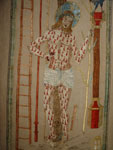ARMA CHRISTI ROLL
IMAGES OF THE PASSION OF CHRIST
Stonyhurst College, Clitheroe, Lancashire, England
Arma Christi Roll,
English, ca. 1440 (poem late 14th century)
Text similar to London, Brit. Lib., Add. 22029, published by R. Morris,
ed., Legends of the Holy Rood; Symbols of the Passion and Cross-Poems.
Early English Text Society os 46 (London 1871), 171-93.
Twenty-four illustrations
colored in pink, green and gold, in a naive style, and generally similar
to those the Arma Christi Roll in the British Library, London, Add.
22029:
1, the Vernicle with the face of Christ in the center of a large cloth,
geometrically divided; 2, knife for the Circumcision; 3, pelican in
its piety; 4, thirty pieces of silver; 5, lantern; 6, sword and stave;
7, rod; 8 (image of a hand with strands of Christ's hair and the hand
that slapped him not part of Stonyhurst Ms, but text is retained); 9,
cloth to blindfold Christ; 10, dice and the unseamed coat; 11, two scourges;
12, crown of thorns; 13, pillar entwined with ropes; 14, standing Christ
holding the cross; 15, three nails; 16, vessel; 17, rod with sponge;
18, spear; 19, ladder; 20, hammer; 21, pliers; 22, the face of Christ
in the center with a Jew spitting at him from either side; 23, cross
with a nail at each end; 24, sepulchre with Christ's body lying in it.
The Stonyhurst scroll
is very similar to the Arma
Christi Roll in the Huntington Library, Pasadena, California HM
26054. That roll was kept in a green silk bag with a drawstring. It
was written in the second half of the fifteenth century and acquired
by the Huntington Library at Sotheby's, 11 April 1961, lot 139. (J.
Preston, "Medieval Manuscripts at the Huntington: Supplement to
De Ricci's Census," Chronica: a Newsletter Published by the
Medieval Association of the Pacific 21 (1977) 2-9)
The poem first appeared
in Middle English before the end of the 14th century. More than 15 copies
of the poem survive, testifying to its high popularity as an example
of devotional literature. Eight copies of the poem are written on rolls,
as is the Stonyhurst manuscript, most averaging 5 to 6 feet in length.
No other religious text written in scroll form survives in more than
one text, which indicates that the Arma Christi's function was clearly
linked to the scroll's ability to present text and image in a continuous
format. The evidence of comparative manuscripts strongly suggests that
the roll was made for public use, to be "publicly displayed in
churches to stimulate the devotion of the 'lewd' (ordinary) folk."
(R. H. Robbins, "The 'Arma Christi' Rolls," Modern Language
Review 34 (1939) 415-21, quote p.417)

The Fetternear Banner,
about 1520 (National Museum of Scotland) is a processional banner showing
Christ displaying his wounds and signs of the passion, like those on
the Arma Christi rolls.
The following is
a modernized text of sections of the poem, which develops in rhymed
couplets. Often a couplet - or more - describes the objects associated
with Christ's Passion and then following couplets instruct readers/listeners
on how to consider Christ's sacrifice piously.
 Early
in the text the concept of Christ's sacramental blood nourishing the
faithful is introduced by the often-used symbol of the pelican. (Compare
Huntington Library HM 26054 Image 2) According to ancient texts,
the pelican in times of drought would open up its breast and feed its
young with its blood. The symbol became known as the Pelican in its
Piety and was frequently illustrated in liturgical contexts such as
on altar vestments. The poem explains:
Early
in the text the concept of Christ's sacramental blood nourishing the
faithful is introduced by the often-used symbol of the pelican. (Compare
Huntington Library HM 26054 Image 2) According to ancient texts,
the pelican in times of drought would open up its breast and feed its
young with its blood. The symbol became known as the Pelican in its
Piety and was frequently illustrated in liturgical contexts such as
on altar vestments. The poem explains:
The pelican
his blood doth bleed
Therewith his birds to feed.
It betokenth upon the rood (cross)
Our Lord fed us with his precious blood.
Then he us bought us out of hell
In joy and bliss with him to dwell
And be our father and our food
And we his children meek and good.

